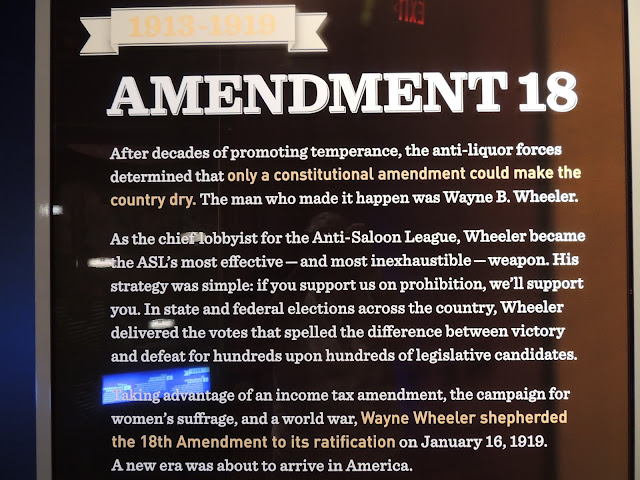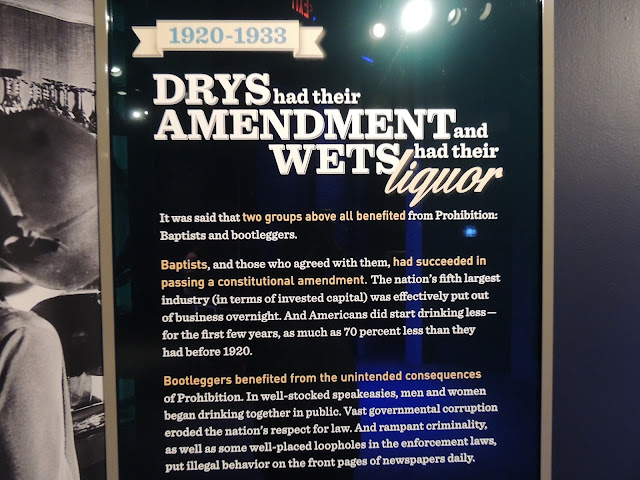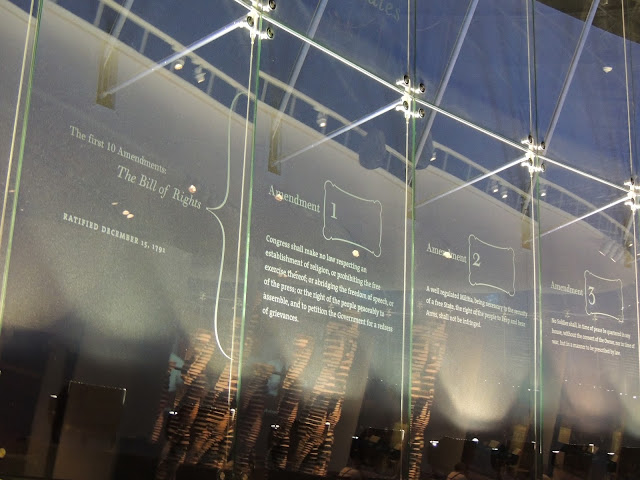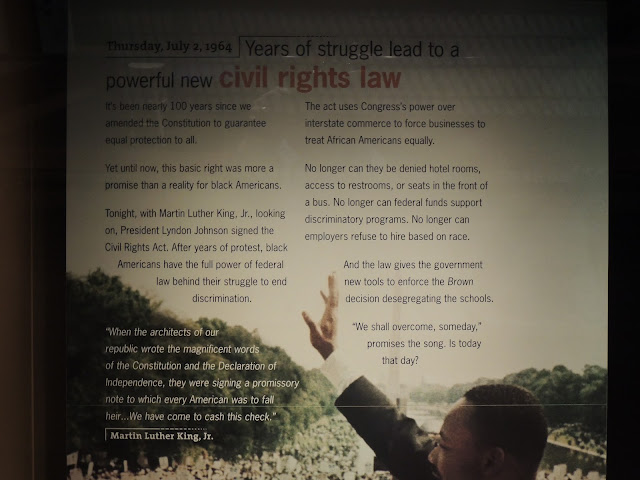Philadelphia PA
National Constitution Center
Prohibition Exhibit
Signers Hall
The Constitution
American Spirits... The Rise and Fall of Prohibition
Ever wonder what the breweries did to stay alive during Prohibition? We did, so here's an article from Mental Floss.
mentalfloss.com/article/55157/how-breweries-kept-busy-during-prohibition
How Breweries Kept
Busy During Prohibition
BY NICK GREENE
Before
Prohibition, there were over 1300
breweries in the United States, and the popularity of ales and lagers was
at an all-time high. The party ended in 1920, however, when beer was deemed an
"intoxicating liquor" by the Volstead Act—the legislation passed to
enforce national prohibition and the 18th Amendment—and it became illegal to
make, transport, or sell suds.
Unlike
underground distilleries that could whip up batches of illegal liquor with
little threat of detection, breweries were often big, tax-paying businesses
that couldn't just slip into the woods with their massive boil kettles and
lauter tuns. How did the few breweries that survived the 13 years of
Prohibition do it?
The
18th Amendment didn't pop up overnight, and some brewers had time to prepare.
Prohibition was a topic of national debate since before there was even a
nation, and its enforcement was centuries in the making.
In
1885, a group of German-American brewers called the Wisconsin State
Anti-Prohibition Association published a pamphlet arguing against new
taxes and a proposed ban on one of the state's most lucrative products:
Many
thousands of people are doing business with the brewers, many thousands of
laboring men, mechanics, and artisans...And the prohibition fanatic who wants
to destroy the business at once by legislation will please step forward and
tell us what he would give to [Milwaukee] in return for the destruction of its
most extensive and important business interest.
Beer
in America was popularized by German immigrants, and German-Americans owned and
operated most of the breweries. During WWI, anti-German sentiment ran rife so
arguments like the one above went ignored (or were used as an example of beer's
inherent evil). The country was sliding towards a full alcohol ban and was
already primed by temporary wartime prohibition, which was enacted in order to
preserve the nation's grain supply. Breweries could only make "near
beer," or beer that didn't exceed an alcohol content of 2.75%. Once
the Volstead Act was put in place, that number had to drop to 0.5%.
Many
breweries stuck to near beer, but others that had the means were able to get
creative:
Ice
Cream
Both
Anheuser-Busch and Yuengling refocused their manufacturing attentions on a more
legal vice: ice cream. Anheuser-Busch owned a fleet of refrigerated trucks and
used them to transport their new brand of dessert.
Yuengling
became the Yuengling Dairy Products Corporation and kept making ice cream until
1985.
Pottery
Adolph
Coors' glass works (which had originally produced bottles for Coors beer) was
converted to a porcelain and pottery company long before Prohibition was an
immediate threat. During the alcohol ban, Coors expanded its pottery
division
and mass-produced ceramic tubes and rods for the military and dinnerware lines.
Malt
Extract
Many
breweries, including the manufacturers of Schlitz, Miller, and Pabst,turned their attentions to
malt extract.
They advertised it as a cooking product and put the following instructions on the packaging:
"For bread making use one half as many tablespoonsful of malt extract as
formerly used of sugar. This will make the bread light and perfectly browned.”
The
real reason people bought it, however, was to use it in making their own beer,
or "home brew." Brewing beer at home was illegal under the Volstead
Act (unlike wine, which one was allowed to make), and many malt extract
producers ended up being raided by Prohibition agents. A court eventually ruled
that the extract was legal, and people were able to make as much, um, bread as
they wanted.
Dyes
WWI
stalled the importing of dyes to the U.S., and this "dye famine"
lasted long after the war's conclusion. This coincided with Prohibition and,
rather serendipitously, many brewers noticed their existing equipment could easily be converted
into making dyes.
F. M. Schaefer Brewing Company, Nuyens Liquers, and the Lion Brewery (renamed
The Noil Company) all restructured their operations to make dyes.
Brewery
owners weren't the only people who noticed the similarity between alcohol and
dye production; in a tasty reversal, many dye chemical plants converted to make
illegal hooch.
Read
more about the process of turning a brewery into a
dye plant here.
Beer
Beer
makers knew Prohibition wasn't going to last forever—I mean, come on, have you
tasted beer? That's why Anheuser-Busch got permission from the government to produce 55,000 barrels
of real beer to
have ready when the ban on alcohol ended. America was going to have to toast
with something, after all.
Now to the Exhibit
In 1830 the average American over the age of 15 consumed 90 bottles of 80 proof liquor per year. That is four shots every day of the year, and that's not including the home remedies that contained alcohol.
did you know? John Adams began each day with a tankard of hard cider.
A cider jug.
By 1737, 228 synonyms for drunk. Love Ben Franklin
And?
Being from St. Louis, MO, I had to get the photo of the Anheuser Busch Eagle and other memorabilia. The Hatchet says, "All Nations welcome but Carrie."
Some Banners carried by the temperance groups.
WCTU.. The Women's Christian Temperance Union
Propaganda Posters
Timeline to Prohibition
I took the test, I'm a "DRY". OK friends, no giggling.
Billy Sunday.
William Jennings Bryan
Carry Nation
Howard Hyde Russell
Love the code words...
We got caught and booked. I guess we shouldn't be smiling, but the repeal is coming.
The National Constitution Center
Signers Hall
There are 42 Life Size bronze statues of the Founding Fathers standing in this hall.
The tall fellow is Thomas Jefferson, the tallest of all the presidents at 6' 21/2" He was not actually at the signing of the Constitution, because he was in France as the Ambassador.
The guy sitting in front of him is Benjamin Franklin.

As a side note, our shortest president was James Madison at 5' 4"
He wrote the constitution and was our 4th president. I couldn't find him in my photos, so I borrowed one from the web.
That's George Washington's head in the center.
Gerry was known to be a contrarian, who objected to most everything.
The Constitution
How did we get from declaring our independence from Britain to setting up a "United States?"
Are we finished?
https://constitutioncenter.org/learn/educational-resources/historical-documents/constitution-fast-facts
THE CONSTITUTION OF THE UNITED STATES: FAST FACTS
- The U. S Constitution was written in the same Pennsylvania State House where the Declaration of Independence was signed and where George Washington received his commission as Commander of the Continental Army. Now called Independence Hall, the building still stands today on Independence Mall in Philadelphia, directly across from the National Constitution Center.
- Written in 1787, the Constitution was signed on September 17. But it wasn’t until 1788 that it was ratified by the necessary nine states.
- The U.S. Constitution was prepared in secret, behind locked doors that were guarded by sentries.
- Some of the original framers and many delegates in the state ratifying conventions were very troubled that the original Constitution lacked a description of individual rights. In 1791, Americans added a list of rights to the Constitution. The first ten amendments became known as The Bill of Rights.
- Of the 55 delegates attending the Constitutional Convention, 39 signed and 3 delegates dissented. Two of America’s Founding Fathers didn’t sign the Constitution. Thomas Jefferson was representing his country in France and John Adams was doing the same in Great Britain.
- Established on November 26, 1789, the first national “Thanksgiving Day” was originally created by George Washington as a way of “giving thanks” for the Constitution.
- Of the written national constitutions, the U.S. Constitution is the oldest and shortest.
- At 81, Benjamin Franklin of Pennsylvania was the oldest delegate at the Constitutional Convention and at 26, Jonathon Dayton of New Jersey was the youngest.
- The original Constitution is on display at the National Archives in Washington, D.C. When the Japanese bombed Pearl Harbor, it was moved to Fort Knox for safekeeping.
- More than 11,000 amendments have been introduced in Congress. 33 have gone to the states to be ratified and 27 have received the necessary approval from the states to actually become amendments to the Constitution.






















































































































































